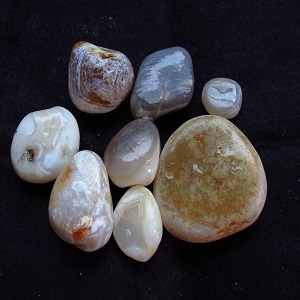Andalusite mineral

The rocks in this collection include pelitic schists, marble and schist amphibole, which are interrupted by granite masses and pegmatite veins. Andalusite is found in metamorphic and igneous rocks with textural, geochemical and crystallographic differences in the Ten Salam complex. Andalusite is one of the polymorphs of aluminosilicate, which is often formed in the metamorphic conditions of medium temperature and low pressure. New experimental research shows that this mineral is also formed in magmatic and metasomatic conditions. Chemical analyzes performed with electron microprobe show that iron, potassium and REE elements are different in two types of andalusite occurrences in Deh Salam. The iron in andalusite found in igneous rocks ranges from 0.12 to 0.97% and its potassium content reaches 0.79%
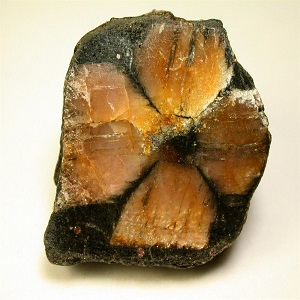
In andalusite, iron transformation is 0.11 to 0.16% and potassium is very small and often less than 0.02%. Other main elements present in two types of andalusite do not show any significant difference. Andalusite crystals in the metamorphic rocks of the Deh Salem complex are seen in andalusite-bearing schists in the form of chiastolite and with oriented accumulation. This mineral is formed from pelitic rocks during progressive metamorphic reactions. The paragenesis in these schists shows the formation temperature of 380 to 450 degrees Celsius at a pressure of 2 to 3 kilobars. Andalusite found in the igneous rocks of Deh Salam complex in the margin of granite masses and pegmatites is pink in color and without carbon inclusion and unlike metamorphic types, it has no orientation. This mineral can be formed from an alkaline metalaluminum magma that has been in ion exchange with its neighboring metamorphic rocks. Examining the changes in the ratio of potassium to sodium from metamorphic halo schists to the granite mass confirms the presence of ion exchange and metasomatism between magma and intrusive rocks
Characteristics of andalusite
Andalusite is an ore that is resistant to high temperatures. Andalusite can show shades of green, brown and red from different directions. Although it is hard enough for most jewelry uses, it is a remarkably beautiful stone that is known primarily for jewelry purchases
Andalusite is an aluminum silicate mineral that can be found in low pressure metamorphic rocks. It consists of Sillimanite and Kyanite
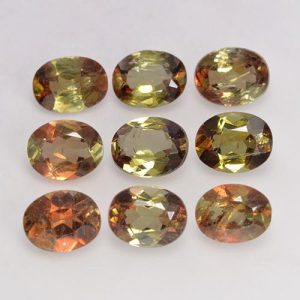
Andalusite is known for its ability to change color when viewed from different angles. Stone colors are due to the beauty of the face
It is named after the place where it was first discovered, Andalusia, Spain
Gem quality samples are cut into cabochons
Location of Andalusite: It is commonly found in Sri Lanka, Brazil, France, Sweden, Russia, Spain, China, Australia and the United States of America
Andalusite is formed during regional metamorphism of shale or oil-bearing rock. It can be found in metamorphic rocks of schist and green jade. Andalusite is often associated with kyanite (primary) and sillimanite stones
Andalusite also forms during the metamorphism of bituminous rocks. In this situation, it can be formed inside the metamorphic rock or in the veins and cavities inside the igneous rocks. It can be along with cordierite (it is one of the rare minerals) in Hornfels (it is formed due to the nearby transformation of granitoids), granite and granitic pegmatite

Difficulty: 7.5-7
Crystal shape: Orthorhombic
Transparency: transparent to matte
Specific gravity: 3.1-3.2
Refraction: uneven, chip-like
Hardness: Brittle
In the group: silicates, individual tetrahedral silicates or island silicates
Transparency: transparent to opaque
Absorption spectrum: The deep green variety from Brazil shows the Mn spectrum: knife-edge shadow at 5535, fine lines at 5505 and 5475. faint lines at 5180, 4950 and 4550
Phenomena: Chatoyancy (cat’s eye), very rare
Formula: Al2SiO5 + Fe
Pleukroicism: strongly pleukroic; Olive green to fleshy red (Brazil). Usually yellow/green/red. Blue andalusite from Belgium: blue / colorless / colorless
Optics: α = 1.629 – 1.640; β = 1.633-1.644 γ = 1.638-1.650. Near colorless andalusite is reported at the lower end of this range. Green material at the upper end. Viridin: 1.66-1.69. Biaxial (-), 2V = 73 – 86 degrees
Optical sign: biaxial
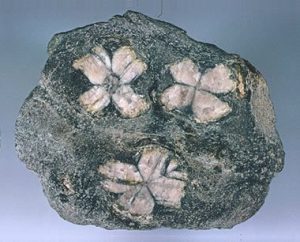
Occurrence: Metamorphic rocks, usually slates and schists, occur as a contact mineral, or within mica schist or gneiss. Also as a detrital mineral and rarely in pegmatites and granites
Impurities: rutile needle (common); liquid components, hematite shells (Brazilian material); Carbonaceous components (Kiastolite)
Common improvements: Thermal improvement
Location: Andalusite is found in different environments, especially in the metamorphosed types of cordierite, hornfels, granite and granitic pegmatite
Rock type: igneous, sedimentary, metamorphic
Gem shapes with a long axis, such as an oval, marquise, or emerald cut, tend to show one color near the center and another, usually darker, color toward the end
Sometimes, lapidaries pass through these stones to reveal pink and almost colorless shades. Others are cut to show the green color in the center of these stones, with brown or various other combinations at the tip, depending on the crystal orientation before cutting
Other names used for andalusite
Cross stone, Chiastolite, Viridine
Some andalusite mines
Spain, Sri Lanka, Brazil, Australia, America, Canada, Russia
How to clean andaluzite
Sensitive to steam cleaning, ultrasound may be used, preferably with cold water and soap
Diagnosis of andalusitis
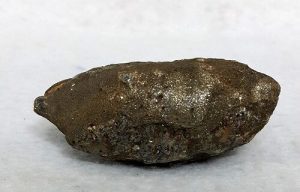
Only some gemstones such as tourmaline, chrysoberyl, sphene, smoky quartz and vesovianite are similar to andalusite and are confused with it
There are many colors in jewelry with different strengths from weak, distinct or strong. Multicolored effects appear as a result of different absorption of light rays, and this phenomenon occurs only with birefringent crystal
Andalusite, along with uolite, kyanite, kunzite, sphene and tanzanite, are extremely multi-colored.
Andalusite has triple polychrome; When light enters the rock, it splits into three parts, each containing part of the visible spectrum
Some multi-colored gemstones, such as multi-colored Kunzite, have bicolors, which means they only display two different colors. Andalusite shows a slightly higher degree of hardness than quartz in the Mohs scale
The brilliance and clarity of andalusite
Andalusite is usually found in translucent to opaque form, with the quality of a clear and rare gemstone. Opaque species are known as chiastolite. The dark cherts in Chiastolite are formed in the form of crosses, and thus they are often referred to as “cross stones”
Chiastolite is usually white, gray or yellowish and is softer than transparent andalusite (or 5 to 5.5 hardness on the Mouse scale). Clear andalusite has gem quality only to a small percentage.
Almost all andalusite gemstones contain visible inclusions, often needle-shaped rutile. After polishing, andalusite will have a vitreous to opaque luster
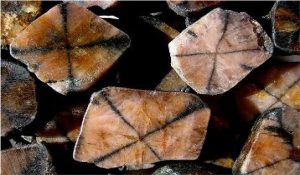
Types of andalusite cuttings and shapes
Andalusite can be said to be almost always cut, except for the matte varieties with brilliant cuts and rarely in the shape of a wedge. Andalusite color is enhanced through proper rotation and quality cutting. Naturally, andalusite without proper cutting will not have the beautiful colors of brown, green and reddish brown
Oval, asparagus and emerald cuts are very popular due to their long axes
Square and round cuts are also very important because of the attractive mosaic color combination
Since andalusite is considered one of the lesser known gemstones, trillion, heart and other fancy shapes are not as common due to lower demand
Andalusite processing
Andalusite is not usually processed. Some Brazilian species change from olive green to pink when heated, while some brown specimens become colorless when heated above 800°C
Any processing or value enhancement done on the stone must be reported by the providers of the stones
What are the most famous similar gemstones
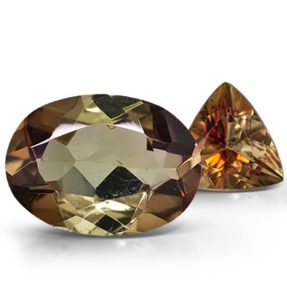
Kyanite, sillimanite, tourmaline, chrysoberyl, cat’s eye chrysoberyl and smoky quartz are some of the most famous gemstones similar to andalusite in terms of color
Andalusite gemstone and jewelry design ideas
Andalusite is a popular stone in jewelry design. Andalusite has good durability and hardness, which makes it suitable for any type of jewelry. This stone has a hardness of 7.5 on the Mohs scale and is harder than quartz
Andalusite crystals are not usually found in large sizes, so they are mostly used as side stones or in cluster designs in jewelry with colored stones
Andaluzite is suitable for use in rings, bracelets, necklaces, pins, tie clips and pendants
Due to its multi-color, it is better to use it in jewelry designs that introduce light to the stone from different angles. Closed settings do not provide the possibility of displaying the desired quality of this stone
Sources of andalusite
Andalusite is usually found as a result of the sedimentation of metamorphic clay in the form of sediment, gneiss and schist
Andalusite rarely occurs as granite or pegmatite, but when it does, it has the largest crystals
Andalusite deposits are found in many places including Australia, Brazil, Canada, Russia, Spain (Andalusia), Sri Lanka, Burma, Madagascar and the United States (California and Colorado)

